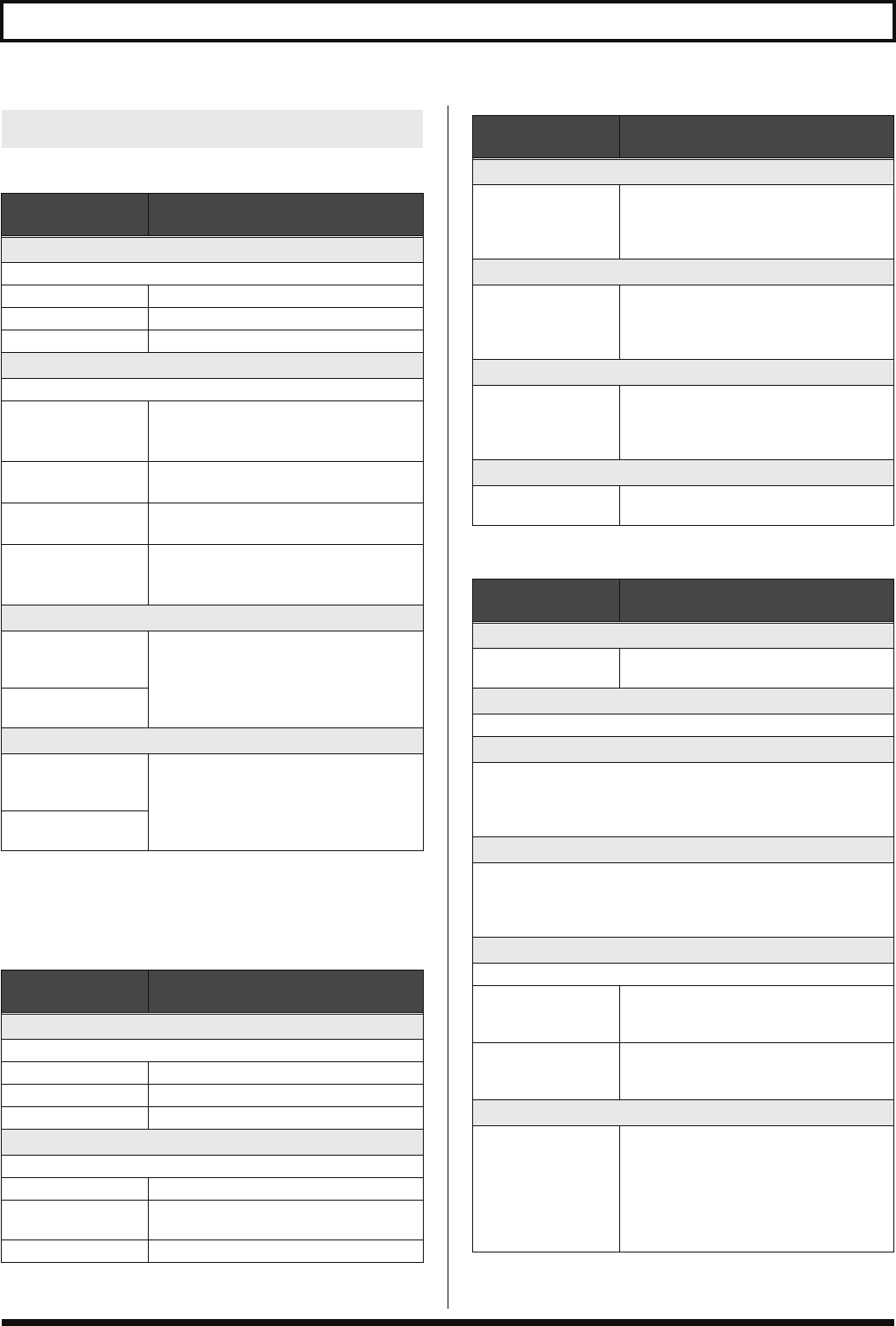
138
Chapter 8 Parameter Guide MASTER
PITCH
FILTER
This passes only portions of the sound’s frequency ranges, giving the
sound a unique tone. You can add different types of expression to
the sound by changing the frequencies (pitches) that are passed.
ASSIGNABLE
*1 Setting available with SOURCE set to RIBBON ACT.
*2 Setting available with SOURCE set to RIBBON POS.
RIBBON
Parameter/
Range
Explanation
T-ARM CH (Tremolo Arm Channel)
This selects the channel to which the tremolo T-ARM is applied.
A T-ARM is applied only to Channel A.
B T-ARM is applied only to Channel B.
A+B T-ARM is applied to both Channel A and B.
TYPE
This selects the T-ARM type.
S-TYPE This simulates the characteristics of a
synchronized-type tremolo arm on the
Fender Stratocaster.
B-TYPE This simulates a Bigsby-type tremolo arm
on the Gibson or the Rickenbacker.
F-TYPE This simulates the characteristics of a Floyd
Rose’s locking-type tremolo arm.
TRANS This simulates how a Trans-tremolo type
arm changes the pitch of all the strings
equally.
DOWN MIN (Down Minimum)
-50–+50
(S-TYPE, B-TYPE, F-
TYPE)
This sets the pitch when the RIBBON CON-
TROLLER is pressed at the end closest to the
front. Setting a negative value raises the
pitch, while setting a positive value lowers
the pitch.
-24–+24
(TRANS)
DOWN MAX (Down Maximum)
-50–+50
(S-TYPE, B-TYPE, F-
TYPE)
This sets the pitch when the RIBBON CON-
TROLLER is pressed at the end farthest
from the front. Setting a negative value rais-
es the pitch, while setting a positive value
lowers the pitch.
-24–+24
(TRANS)
Parameter/
Range
Explanation
FILTER CH (Filter Channel)
This selects the channel to which the filter is applied.
A The filter is applied only to Channel A.
B The filter is applied only to Channel B.
A+B
The filter is applied to both Channel A and B.
TYPE
This selects the filter type.
LPF This filter passes only the low frequencies.
BPF This filter passes frequencies only in the
specified range.
HPF This filter passes only the high frequencies.
Parameter/
Range
Explanation
FREQ MIN (Frequency Minimum)
0–100
This sets the frequency when the RIBBON
CONTROLLER is touched at the end closest
to the front (the minimum value). Raising
the value increases the set frequency.
FREQ MAX (Frequency Maximum)
0–100
This sets the frequency when the RIBBON
CONTROLLER is touched at the end away
from the front (the maximum value). Rais-
ing the value increases the set frequency.
RESO (Resonance)
0–100
Adjusts the amount of filter resonance (dis-
tinctiveness of the sound) used. Raising the
value strengthens the characteristic coloring
of the tone.
LEVEL
0–100
Adjusts the volume level. Raising the value
increases the volume.
Parameter/
Range
Explanation
SW
OFF, ON
This setting switches RIBBON ASSIGN-
ABLE on and off.
TARGET PARAMETER
This selects the parameter to be changed.
MIN (Minimum)
This sets the minimum value for the range in which the parameter
can change.
The value differs depending on the parameter assigned for TARGET
PARAMETER.
MAX (Maximum)
This sets the maximum value for the range in which the parameter
can change.
The value differs depending on the parameter assigned for TARGET
PARAMETER.
SW MODE (Switch Mode) *1
This sets the behavior of the value each time the switch is operated.
MOMENT The setting is normally OFF (minimum val-
ue), switching to ON (maximum value)
while the footswitch is held down.
LATCH The setting alternately switches to OFF
(minimum value) and ON (maximum val-
ue) each time the footswitch is pressed.
RANGE LOW, RANGE HIGH *2
Low: 0–126
High: 1–127
You can set the range for control of target
parameters within the RIBBON CONTROL-
LER’s response range. Target parameters
are controlled within the range set with
RANGE LOW and RANGE HIGH. You
should normally set RANGE LOW to 0 and
RANGE HIGH to 127.
VB-99_e.book 138 ページ 2008年8月18日 月曜日 午後1時10分


















